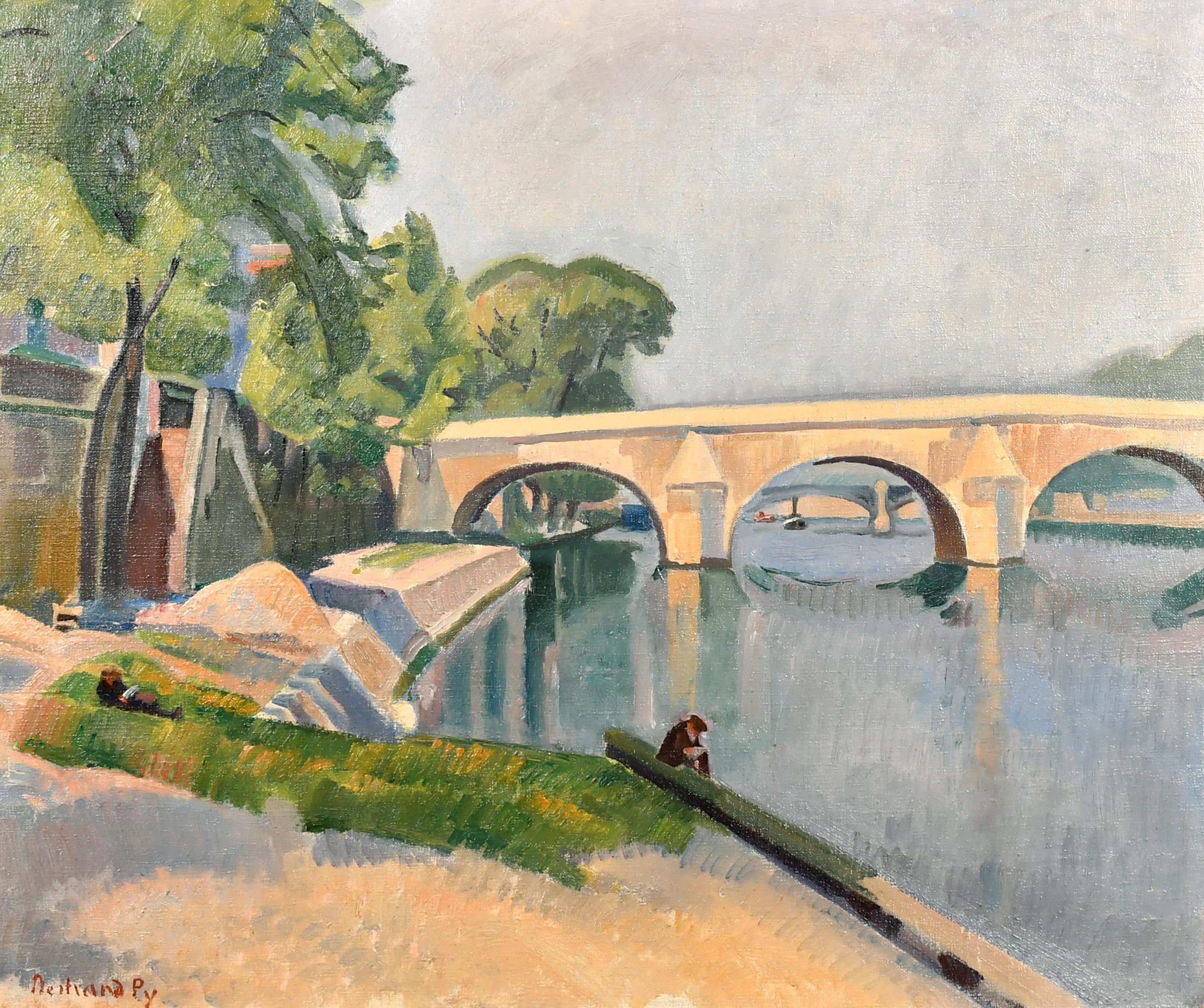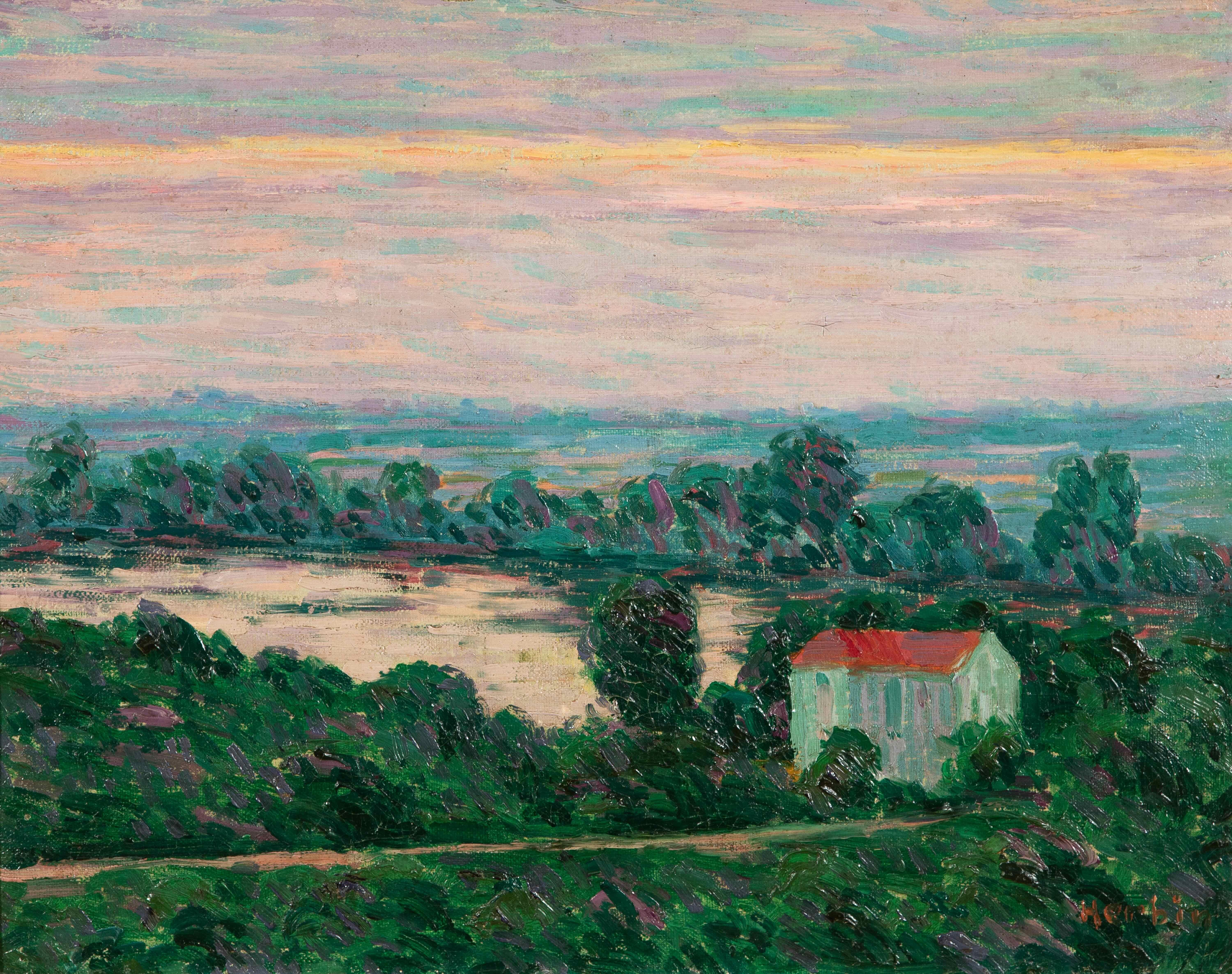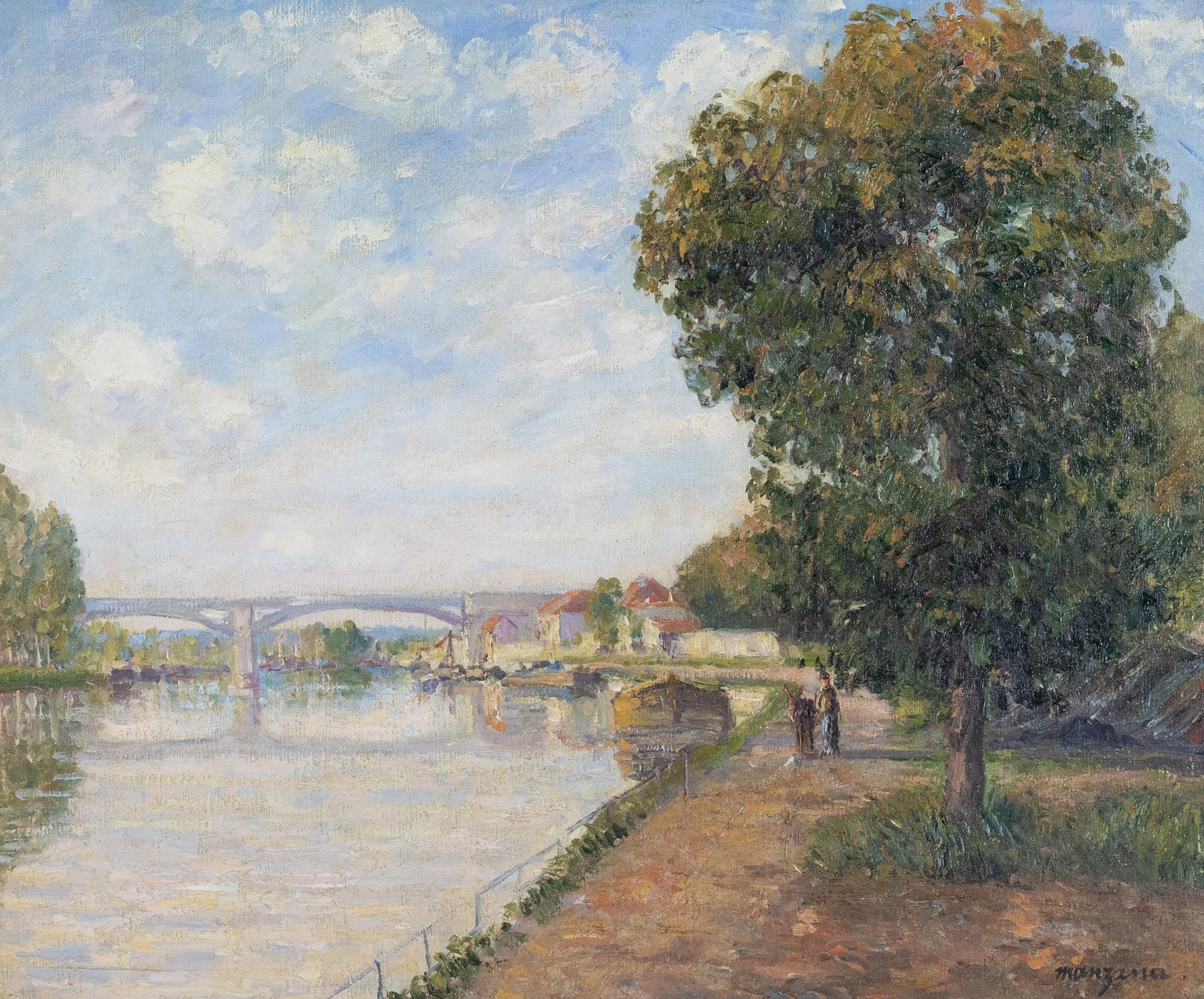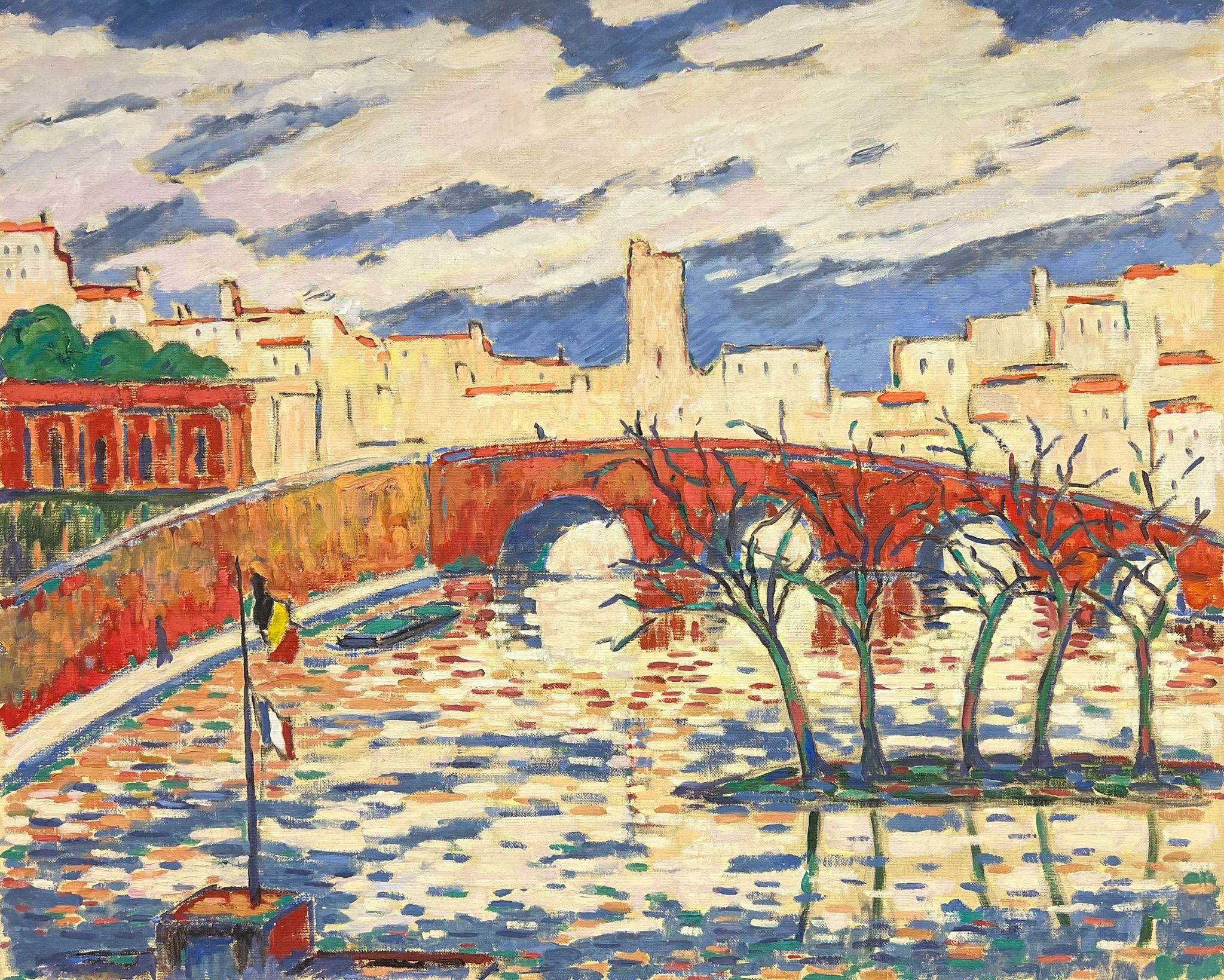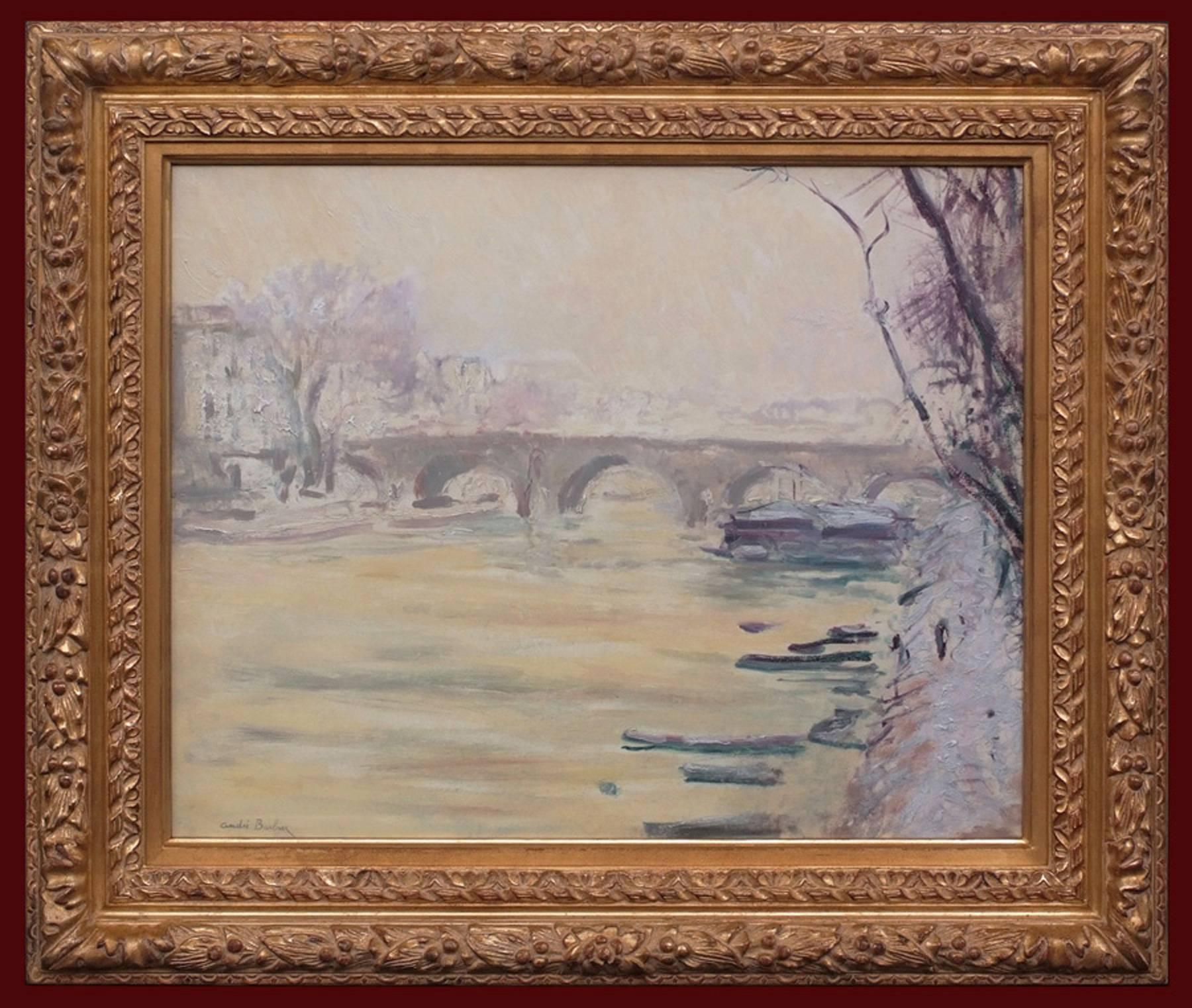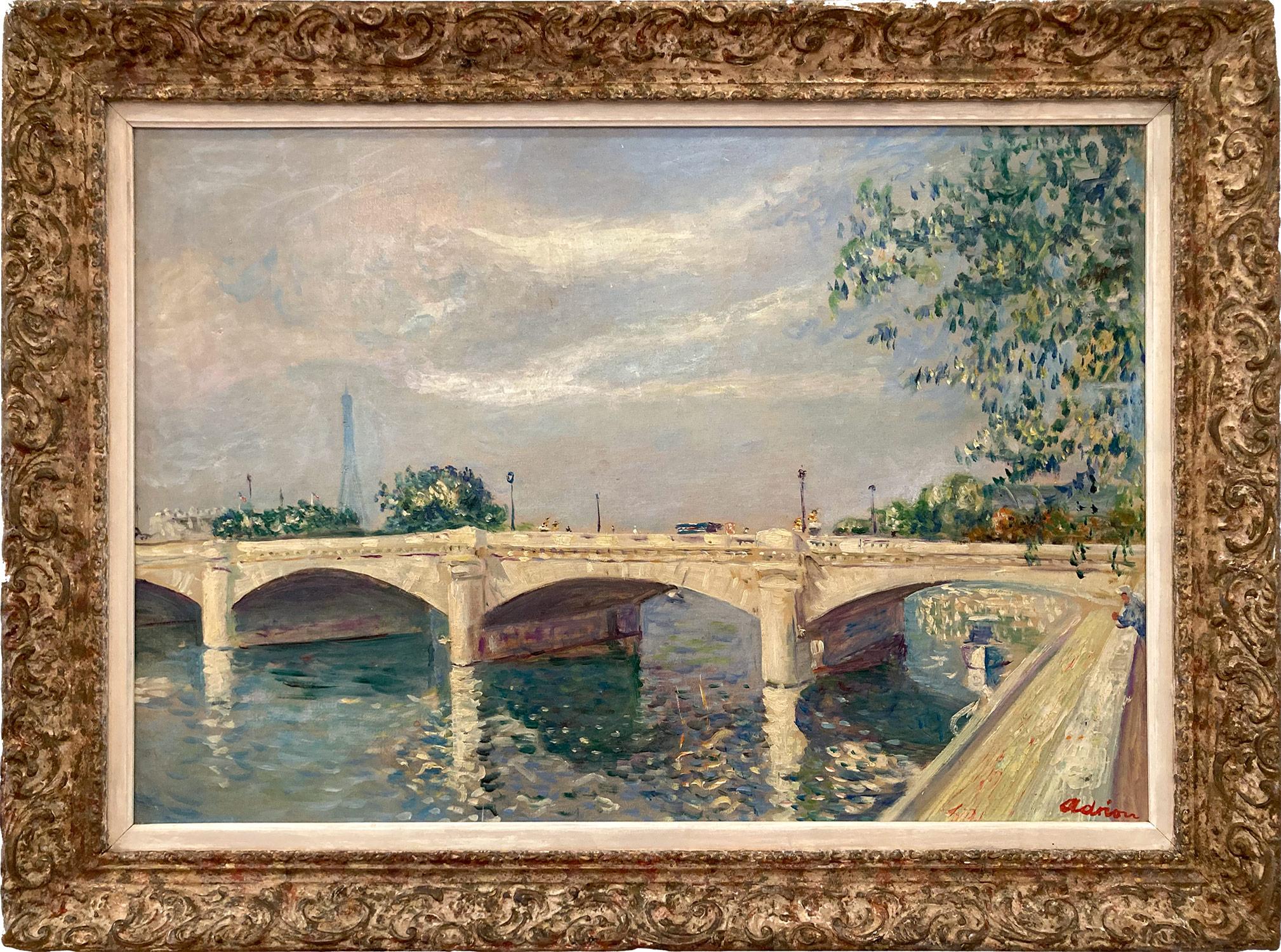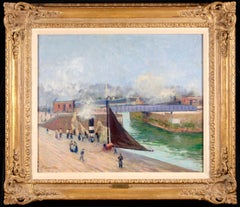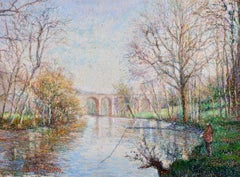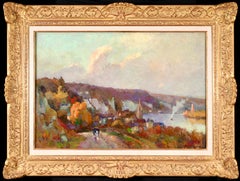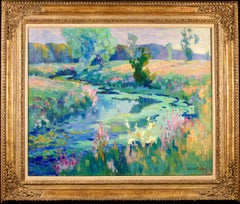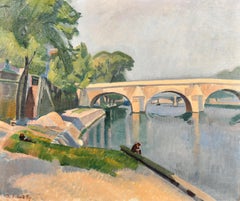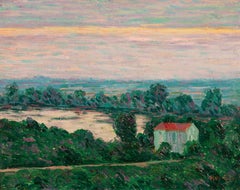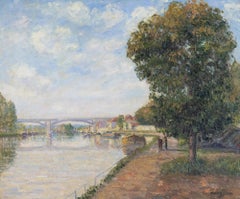Items Similar to Le Pont Royal - Impressionist Landscape Oil Painting by Auguste Royal
Want more images or videos?
Request additional images or videos from the seller
1 of 17
Auguste HerbinLe Pont Royal - Impressionist Landscape Oil Painting by Auguste Royal1903
1903
$144,627.94
£105,555
€123,124.22
CA$198,104.12
A$220,335.03
CHF 115,052.10
MX$2,681,242.90
NOK 1,469,390.94
SEK 1,378,029.47
DKK 918,923.26
Shipping
Retrieving quote...The 1stDibs Promise:
Authenticity Guarantee,
Money-Back Guarantee,
24-Hour Cancellation
About the Item
Signed impressionist oil on canvas riverscape by French modern painter Auguste Herbin. The work depicts a view of the Pont Royal bridge over the River Seine in Paris. The shadowy figures of citygoers are dotted across the bridge and a barge is sailing int he cold water. The trees that line the banks of the river are bare of leaves.
Signature:
Signed lower right
Dimensions:
Framed: 32"x37"
Unframed: 24"x29"
Provenance:
Private collection - France (acquired in 1976)
Literature:
Genevieve Claisse, Herbin: Catalogue raisonné de l'oeuvre peint, Paris, 1993, p. 283, no. 22 (illustrated).
Genevieve Claisse, Herbin, Les Editions du Grand Pont - illustrated in full page colour p.21
Auguste Herbin began studying drawing at the École des Beaux-Arts in Lille in 1900-1901. In 1903 he went to live in Paris and in 1909 to a studio in the building known as Laundry Boat ( Bateau-Lavoir) in Paris.
During his apprenticeship his style was influenced by the Impressionism and Post-Impressionism of Cézanne and Van Gogh, as may be seen in his canvases exhibited at the Salon des Indépendants in 1906. From that date his shapes and colours progressively free themselves from representation of objects to reveal their structural independence, perhaps echoing the first shake-up inflicted by Fauvism on the Impressionist legacy, and from this point his work is referred to as Fauve. Then he became involved in the first Cubist experiments. In 1910 he exhibited at the Salon des Indépendants in the same room as Metzinger, Gleizes and Fernand Léger. Such grouping may not have been pure chance but a sure sign of a distinctively French Cubism to be illustrated by other artists including La Fresnaye, Jacques Villon and André Lhote.
What is striking in the works from his Cubist period, called 'Prismatic Cubism', is that they are not at all detached from reality but a pictorial transcription of reality in all its detail and all its flavour. Despite this dependance on the real, he was one of the first painters in France, along with Gleizes, Valmier and Hélion and then Delaunay, Kupka and Arp, to move to pure Abstraction. From 1912 this new direction was noticeable and was evident in all his subsequent works. In 1916 he decorated a chapel at the military camp in Mailly in Champagne. From 1922 to 1925 he returned briefly to Figuration, with the Cubist depiction of Haute-Provence landscapes, yet submitted to rigorously geometric scansions.
Following this, in which the ultimate interrogation of the foundations of the creative act should be seen before definitive determination, he devoted the rest of his life, from 1926 until his death, to the creation of one of the most determined works in the history of Abstract art. The very personal way he embarked on Cubism finally led him to a completely new three-dimensional art, which he explained in his book L'Art Non Figuratif Non Objectif of 1949. This book expounds on the general principles and particular methods behind the conception of all of his works of the last 35 years, which constitute the Plastic Alphabet period.
Herbin took up some of the ideas proposed by Kandinsky in Du Spirituel dans l'Art et dans la Peinture en Particulier of 1911. Kandinsky had himself been inspired by Goethe's Theory of Colours on the allegorical, symbolic and mystical potential of colour. For Herbin, the emotional perception of shapes and colours passed through a synaesthetic drift which associates particular shapes and colours with precise sensations. Moreover, the energy of a specific colour is closely linked to the dynamic of a particular shape. The permutation of variations generates infinite combinations. Herbin himself said 'colour has in itself a spatial power. Certain colours express the depth of space (blues), others express the space in front (reds). Certain colours express the radiance from within to without (yellows), others from without to within (blues). Certain colours express mobility (reds, yellows, blues), others immobility (white, black and greens), others mobility and immobility depending on the setting (pinks and violets). These results may be modified by the relationship between the colours themselves.' To master this new idea he decided to restrict himself strategically to simple shapes and colours, heralding the primary structures of American Minimalist Abstraction: circles, triangles, squares, rectangles, diamonds and the basic colours: violet, blue, green, yellow, orange, red, black and white. He also drew on the forms of some letters of the alphabet, going as far as to create a word, yet refuting its evocative power. And it was on this seemingly reduced vocabulary and syntax that he based the biggest part of his work.
Through the activity of the Salon des Réalités Nouvelles, which brought together international Abstract artists in the post-war years, and the Lydia Conti and Denise René galleries, which were entirely devoted to the promotion of Abstract art to the public, his work, with its exceptional accomplishment of serenity, had a determining influence on the definition and development of what was called Geometric Abstraction.
He participated in group exhibitions, including the Salon des Indépendants in Paris, from 1903 to 1906 and in 1910. In 1912 he participated in the historic exhibition Section d'Or in Paris, and at the 24th exhibition of the Berlin Secession. He also exhibited in May and August of that year at Der Sturm gallery in Berlin. In 1913 his works were shown at The Armory Show in New York. From 1917 the Galerie L'Effort Moderne, led by Léonce Rosenberg, showed his works alongside works by other artists. He was a significant figure in the history of Abstraction, manifested by the creation of the group Abstraction-Création with Vantongerloo in 1931. This group, following on from Michel Seuphor's Circle and Square ( Cercle et Carré), brought together all the Abstract artists working in or connected with Paris. He was one of the founders of Salon des Réalités Nouvelles in 1946, where he exhibited regularly and of which he was a director until 1955. In 2001 his work was shown in the exhibition Paris-Barcelone de Gaudí à Miró at the Grand Palais in Paris.
He had many solo exhibitions, the first at the Galerie Moderne in Paris in 1914, followed by exhibitions at Galerie Braun in 1930, Galerie Denise René in 1946 and from 1951 until his death, at Mak gallery in Amsterdam, at Major Gallery in London in 1934, in Brussels, Liège and Fribourg and at the Triennale in Turin. Since his death his work has featured in all retrospective exhibitions on the European birth of Abstraction, including Historical Aspects of Constructivism and Concrete Art ( Aspects Historiques du Constructivism et de l'Art Concret) at the Musée d'Art Moderne in Paris in 1977, and Abstraction-Création 1931-1936 at Musée d'Art Moderne in Paris in 1978. Solo retrospective exhibitions have also taken place in London (1961), Bern (1963), at the Céret museum and Musée Matisse de Quievy (1994) and at Galerie Denise René in Paris (1995).
Museum and Gallery Holdings:
Le Cateau-Cambrésis (Mus. Matisse)
Marseilles (Mus. Cantini): Composition (c. 1932)
New York (Solomon R. Guggenheim Mus.): Pink Composition (1947)
Otterlo (Kröller-Müller Mus.): Still-life (1913)
Paris (MNAM-CCI): Air, Fire (1944); Polychrome Reliefs
- Creator:Auguste Herbin (1882-1960, French)
- Creation Year:1903
- Dimensions:Height: 32 in (81.28 cm)Width: 37 in (93.98 cm)
- Medium:
- Movement & Style:
- Period:
- Condition:Very good original condition.
- Gallery Location:Marlow, GB
- Reference Number:Seller: LFA06221stDibs: LU415314655412
About the Seller
5.0
Gold Seller
Premium sellers maintaining a 4.3+ rating and 24-hour response times
Established in 2001
1stDibs seller since 2016
705 sales on 1stDibs
Typical response time: <1 hour
- ShippingRetrieving quote...Shipping from: Marlow, United Kingdom
- Return Policy
Authenticity Guarantee
In the unlikely event there’s an issue with an item’s authenticity, contact us within 1 year for a full refund. DetailsMoney-Back Guarantee
If your item is not as described, is damaged in transit, or does not arrive, contact us within 7 days for a full refund. Details24-Hour Cancellation
You have a 24-hour grace period in which to reconsider your purchase, with no questions asked.Vetted Professional Sellers
Our world-class sellers must adhere to strict standards for service and quality, maintaining the integrity of our listings.Price-Match Guarantee
If you find that a seller listed the same item for a lower price elsewhere, we’ll match it.Trusted Global Delivery
Our best-in-class carrier network provides specialized shipping options worldwide, including custom delivery.More From This Seller
View AllDieppe-Le Pont Tournant - Impressionist Landscape Oil Painting by Paul Madeline
By Paul Madeline
Located in Marlow, Buckinghamshire
Signed and dated oil on canvas landscape by French post impressionist painter Paul Madeline. This beautiful work depicts the Tournant bridge over the River Arques at the seaport in D...
Category
Early 1900s Post-Impressionist Landscape Paintings
Materials
Canvas, Oil
Clecy - Le Viaduc - Post Impressionist Riverscape Oil By Hugues Claude Pissarro
Located in Marlow, Buckinghamshire
Signed and titled pastel on paper circa 1970 by French artist Hugues Claude Pissarro. The piece depicts a view of the Viaduct de Clecy - a bridge over the River Orne in Clecy in the ...
Category
1970s Post-Impressionist Landscape Paintings
Materials
Paper, Pastel
Duclair - La Seine - Post Impressionist Oil, River Landscape by Robert Pinchon
By Robert Antoine Pinchon
Located in Marlow, Buckinghamshire
Fauvist signed oil on canvas riverscape circa 1920 by French post impressionist painter Robert Antoine Pinchon. The work depicts a view of the R...
Category
1920s Post-Impressionist Landscape Paintings
Materials
Canvas, Oil
Paysage D'Ete - Post Impressionist River Landscape Oil by Robert Pinchon
By Robert Antoine Pinchon
Located in Marlow, Buckinghamshire
Signed fauvist oil on canvas riverscape circa 1920 by French post impressionist painter Robert Antoine Pinchon. The work depicts a view a river winding amongst wild flowers fields in...
Category
1920s Post-Impressionist Landscape Paintings
Materials
Canvas, Oil
Vue de Paris - 1906 - Impressionist Riverscape Oil Painting by Camille Roche
Located in Marlow, Buckinghamshire
Signed and dated impressionist oil on panel landscape by French painter Camille Roche. This beautifully coloured piece depicts a view of the River Seine in Paris, France on a bright ...
Category
Early 1900s Impressionist Landscape Paintings
Materials
Oil, Panel
A view from the Pont Neuf - Impressionist Landscape Oil by Charles Guilloux
By Charles-Victor Guilloux
Located in Marlow, Buckinghamshire
Signed and dated oil on canvas riverscape by French impressionist painter Charles-Victor Guilloux. This beautifully painter piece shows a view from the Pont Neuf looking towards the ...
Category
Early 1900s Impressionist Landscape Paintings
Materials
Canvas, Oil
You May Also Like
Le Pont Royal - 1930's French Post-Impressionist Seine Paris City Oil Painting
Located in Sevenoaks, GB
A beautiful 1930's French post-impressionist oil on canvas depicting the Pont Royal bridge on the river Seine in Paris, by Bertrand Py. Excellent quality a...
Category
1930s Post-Impressionist Landscape Paintings
Materials
Canvas, Oil
Petite maison au bord de l'eau by Auguste Herbin - Landscape, Oil painting
By Auguste Herbin
Located in London, GB
*PLEASE NOTE UK BUYERS WILL ONLY PAY 5% VAT ON THIS PURCHASE. once an order is placed we will arrange the VAT of 20% to be reduced to 5%
Petite maison au bord de l'eau by Auguste H...
Category
Early 1900s Post-Impressionist Figurative Paintings
Materials
Oil, Canvas
Pont du Chemin de Fer à Moret by Georges Manzana Pissarro - River scene
By Georges Henri Manzana Pissarro
Located in London, GB
Pont du Chemin de Fer à Moret by Georges Manzana Pissarro (1871-1961)
Oil on canvas
54.5 x 65.2 cm (21 ¹/₂ x 25 ⁵/₈ inches)
Signed lower right, manzana.
Titled and date on the stret...
Category
Early 1900s Post-Impressionist Figurative Paintings
Materials
Oil, Canvas
Pont de l 'Eze Pertuis Vaucluse French Modernist Original Oil Painting
Located in Cirencester, Gloucestershire
Pont de l 'Eze in Pertuis in the Vaucluse in Provence
by Guy Pichon (French 1933-2007)
oil on canvas, unframed
signed
canvas: 24 x 29 inches
provenance: private collection, France ...
Category
21st Century and Contemporary Impressionist Landscape Paintings
Materials
Oil, Canvas
Postimpressionist painting, Bridge over Seine River in Paris
By André Georges Barbier
Located in Saint-Ouen, FR
BARBIER André Georges (1883-1970)
Paris, bridge over the Seine river
Oil on canvas signed low left
Frame gilded with leaves
Dim canvas : 47 X 58 cm
Dim frame : 65 X 76 cm
BARBIER An...
Category
Mid-20th Century Post-Impressionist Landscape Paintings
Materials
Oil
"Pont De La Concorde" Post-Impressionist Oil Painting Across the Seine in Paris
By Lucien Adrion
Located in New York, NY
This work by Lucien Adrion is a wonderful representation of his impressionistic works depicting the "Pont De La Concorde" bridge across the Seine in Paris with the Eiffel tower in the distance. Using a bright palette of colors, Adrion executes this piece with much attention to detail with figures and cars over the bridge and a man leaning against the edge overlooking the bright water and reflections. There is a boat lower right and we can feel the warmth of the sun contrasted with the cool breeze of the water. The figures are wonderfully executed by the artist in a very whimsical way that leaves us with an essence of fun and enjoyment from that sunny day at the Seine. As this tourist destination was a favorite of the artist to find inspiration and highly attractive subjects and compositions to represent. The piece is signed by the artist lower right and titled on verso, it comes housed in a French giltwood frame with hanging wire on verso ready to be displayed.
Art measures 20 x 29 inches
Frame measures 25.5 x 34.5 inches
Lucien Adrion was born May 25, 1889 in Strasbourg, France. He was a French Post-Impressionist painter, draftsman, and printmaker known for his depictions of the French countryside and beaches, as well as Parisian life including landscape, still life, figure, and landmarks paintings. He began his initial studies in Strasbourg as a technical draughtsman. In 1907, at the age of 18, he left his hometown Strasbourg and traveled to Paris, where he found employment in a large drafting company to work as a fashion illustrator. Adrion changed his mind upon arrival and rather than working for a large company, he decided to peruse his artistic career by traveling to London, Munich, and Frankfurt. As the World War broke out he had to go to Berlin, where he studied as an engraver with Hermann Struck, who was also the teacher of Marc Chagall. He remained in Berlin until the war ended and after the demobilization, Lucien would study engraving under Franz Ritter von Struck...
Category
Early 20th Century Post-Impressionist Landscape Paintings
Materials
Canvas, Oil
More Ways To Browse
Laundry Art
Antique Paintings Pink
Antique Military Painting
Royal Palais
Fauve Landscape Paintings
Antique Sailing Painting
French Sailing Painting
Antique Cold Frame
Antique Palais Royal
Barge Painting
Seine River Oil On Canvas
Miro 1978
Laundry Painting
Boat Black And White Sailing
Riverscape Landscape
Herbin Auguste
Miro Gaudi
R A Muller
